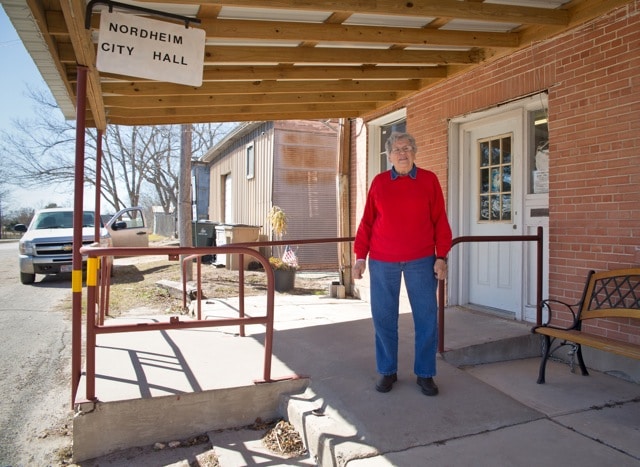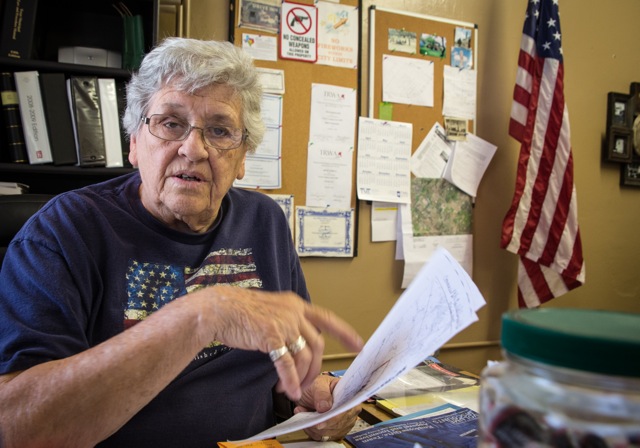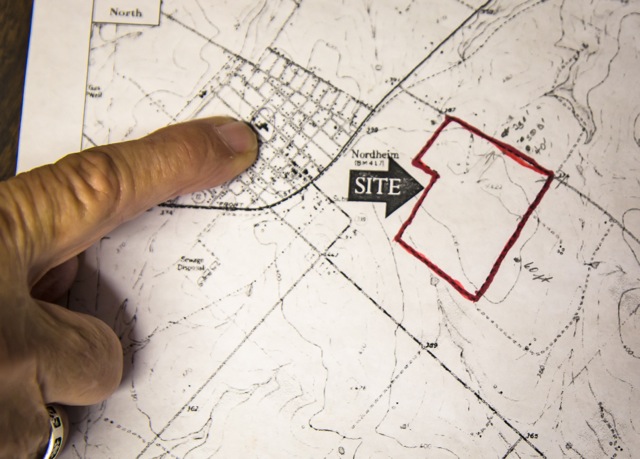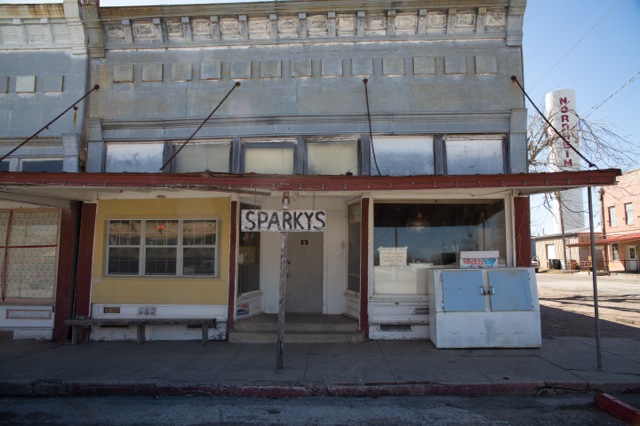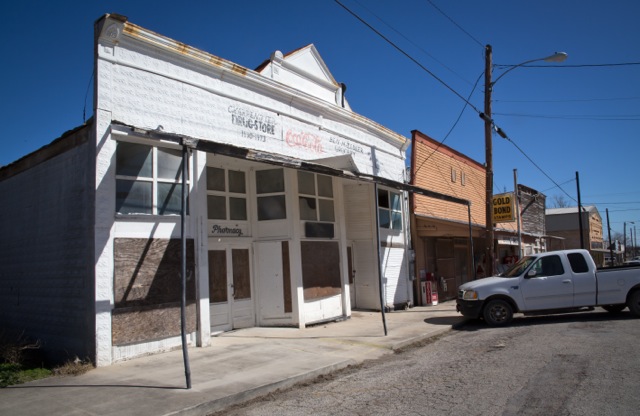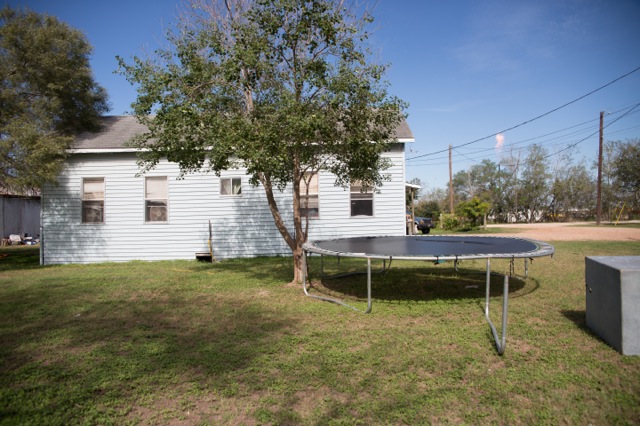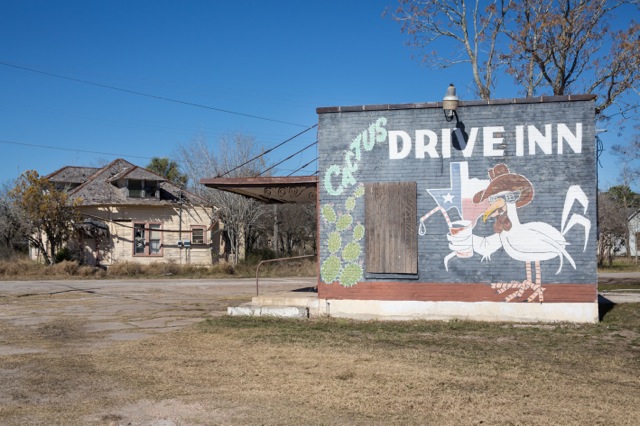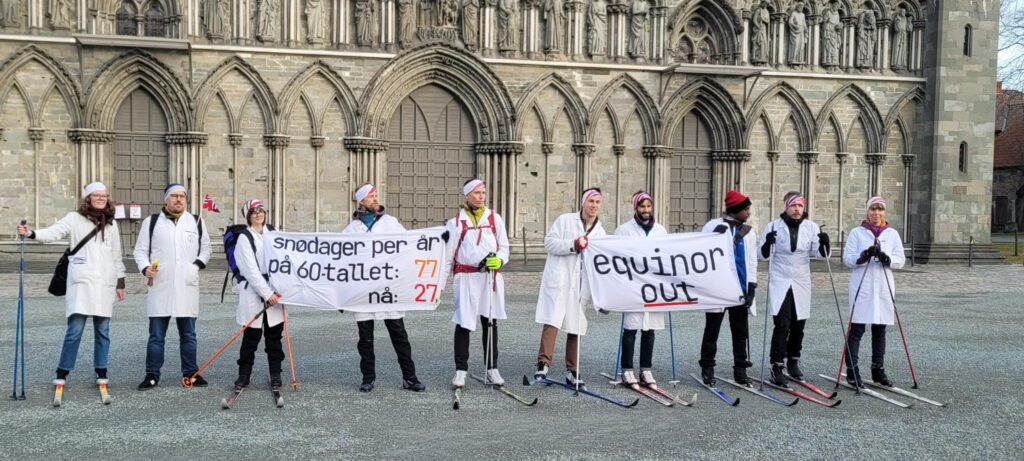Nordheim, Texas, population 307, may soon have a 200-plus acre waste disposal plant as its neighbor despite the protests of the city’s mayor, Kathy Payne.
The small town (one bank, one school, one cafe and a couple of shops) is located in the Eagle Ford Shale region of southern Texas, where vast oil deposits have only recently become accessible through hydraulic fracturing — a process that involves injecting a mixture of water, sand and chemicals at high pressure underground to fracture the rocks and release the oil inside.
Nordheim Mayor Kathy Payne in City Hall. ©2014 Julie Dermansky
Payne learned about the waste disposal plant in the local paper. Because the facility is planned for outside city limits, industry doesn’t have to share its plans with her.
Since reading about the proposal she has done all she can to learn what it will mean for her city with the assistance of Louisiana-based environmental scientist Wilma Subra, who investigates industry hot spots to help citizens make informed decisions about developments coming their way.
The waste disposal site proposed by San Antonio-based Pyote Reclamation Service will be a quarter of a mile outside of Nordheim if it’s granted a permit by the Texas Railroad Commission, the regulatory agency for all things gas and oil in Texas. The facility would have eight pits up to 25 feet deep and span an area almost as big as the town itself. Pyote also has plans to install another facility 3.5 miles away.
Payne points out the footprint of the city is almost the same as that of the proposed waste disposal plant. ©2014 Julie Dermansky
The company was required to provide information about the proposed plant to those living closest to it and to the public library in Cuero, Dewitt County’s seat. Subra, who is vice-chair of Earthworks’ board of directors and co-authored the report Reckless Endangerment While Fracking the Eagle Ford Shale, tracked down the firm’s studies for a closer look.
“There are two binders, three or four inches thick,” she told DeSmogBlog. “The first 30 to 40 pages tell you what is going on.”
Subra will share her findings at a public meeting in Nordheim on February 3. She has a good idea about which toxic materials will be dumped at the plant based on investigations she’s done into similar facilities.
“The plant would have volatile [organic] compounds, including hydrogen sulfide and toxic heavy metals including arsenic, cadmium, lead and chromium that all can be emitted in the air and carried off-site by the wind,” she says. “Emitted toxins from waste disposal facilities will affect an area from five to seven miles away.”
So far, the biggest downside of the fracking boom for the town of Nordheim has been the 18-wheelers passing through, Payne says. However, the installation of a giant waste disposal plant where fracking industry waste would be trucked in from a 100-mile radius will undoubtedly bring more unwelcome changes.
Cafe in Nordheim, Texas ©2014 Julie Dermansky
Payne fears the waste at the disposal plant will contaminate the air and the water. She says the company told her the chemicals will never run off into a nearby creek that feeds into the San Antonio River, but she worries about what would happen in the case of a flash flood.
She also worries that her first responders aren’t equipped to handle an industrial-scale fire. Payne says Pyote representatives assured her the plant will never catch on fire. But many of the materials Subra suspects would be dumped at the plant are flammable.
“What makes them think lightning won’t hit it? Lightning hit an injection well close to the city and blew up the tank,” Payne says.
Payne takes issue with the company’s use of the word “never.” To her, assuming “never” is inviting disaster.
Main Street in Nordheim, Texas ©2014 Julie Dermansky
Payne intends to present her objections to the Texas Railroad Commission personally when it holds a hearing about the permit in the near future. She doesn’t see a need to hire a lawyer or use the industry’s technical terms, believing it is enough to cite common sense facts.
“Surely if the contaminants that get on trucks within the disposal plant are toxic enough to merit cleaning before they leave the facility, the toxins are a danger to the city,” Payne says.
Since the Texas Railroad Commission’s regulations do allow for some leaching of contaminants into the soil, Payne is concerned the shallow aquifer that supplies water to the area could be contaminated.
DeSmogBlog asked the Texas Railroad Commission what circumstances could lead to denying a permit for a waste facility so close to a city. Spokesperson Ramona Nye sent a link to the rules they follow. When asked if the commission had turned down any proposed waste disposal sites in 2013, Nye didn’t provide an answer, explaining: “This information is not readily available and would require staff research.”
Flare from a fracking site visible just outside of Nordheim city limits. ©2014 Julie Dermansky
“Government regulation is not a popular idea, but you have to regulate some things,” Payne says. “In 2008, we had one well in DeWitt County and in 2013, 10,493 wells were drilled in Dewitt County.”
Payne points out that the fertilizer plant that blew up in West Texas hadn’t been inspected in years and the facility in West Virginia that contaminated the area’s water supply hadn’t been subject to inspection recently either.
For Payne, the worst-case scenario is a citizen getting sick from the waste facility. Does she think she can stop the Texas Railroad Commission from approving the permit for the waste disposal plant?
“No,” she told DeSmogBlog, “I don’t, but I am going to do what I can to protest this anyway.”
Blighted house across from a closed business in Nordheim, Texas ©2014 Julie Dermansky
Subscribe to our newsletter
Stay up to date with DeSmog news and alerts


